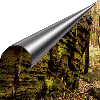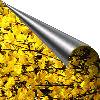

 | Ojcowski National Park |  |




 | Ojcowski National Park |  |


The symbol of the Park is a bat in flight. Out of the 21 bat species living in Poland, 17 may be found in the Park. The Ojcowski National Park was established on January 14, 1956. It has an area of 1,890 ha of which forests occupy 1,349 ha, and 251 ha fully covered with forest are under strict protection. It is a second smallest among the Polish National Parks. The wealth of the Ojcowski National Park embraces rich plant and animal life, an unusual landscape made up of canyons up to 120 m deep, and white limestone cliffs containing innumerable caves (in fact about 215), formed by the eroding action of water. The Park's Museum, located in Ojcow, houses a rich collection exemplifying the region's flora, fauna, geological samples and archeological discoveries. The village of Ojcow, with the ruins of a castle, and nearby Pieskowa Skala Castle, are tourist centers located within the park boundary.
Natural values
Ojcowski National Park is situated in the Jura Krakowsko-Czestochowska, just north of Krakow. The Park encompasses the most beautiful fragments of the Krakow-Wielun Upland. It entails the Pradnik and Saspowska Valleys and a number of side ravines. The view of the Pradnik Valley as it is seen from both the high vantage points such as the Okopy Hill, and from some points at the bottom of valleys, is truly unforgettable. The most famous one is certainly the view of Hercules' Club with the Pieskowa Skala Castle in foreground (seen above). The sight includes a characteristic, lone standing rock 25 m high, which owes its name to the shape, with the renaissance castle, perched on the slope and hidden in green trees in the distance. Another picturesque place is the karst form, known as Krakowska Gate, carved by geological processes through millenia in the limestone.
The Jura owes its present day shape mainly to the sea from the distant past and its inhabitants. Warm sea waves rippled there 140 million years ago, supporting rich life. Skeletons and shells of organisms, deposited at the sea bottom, were eventually converted into rocks, which in turn were exposed to the action of water, temperature, and wind. This history is witnessed by very common findings of ammonite, snail and other fossils in the rocks. The limestone, which builds Jura is continuously eroded by water, and this process creates caves, crevasses and island mountains. The largest number of these forms may be found in the region of Ojcow.
While in Ojcow, a tourist should visit one of the famous caves (guided tours only) - the Ciemna Cave or Lokietek Cave. The Ciemna Cave is a 230 m long system of corridors and chambers, where traces of human settlement from 120,000 to 115,000 B.C. have been found. The Lokietek Cave, which is 270 m long, is reputed to be a shelter, used by the Polish King Wladyslaw Lokietek in 14th century.
Natural life
The richness of this small Park embraces luxurious plant and animal life. Beautiful mixed forests cover most of the Park area, especially around Zloty Potok. Rare species of plants, including plants typical of mountainous regions (Aconitum gracile, Aconitum moldavicum, Veronica montana etc.) and those of a much warmer climate (Stipa Joannis, Melica transsilvanica, Cirsium pannonicum etc.) are easily found in the Park.
Fauna is represented by small mammals typical of a climatic zone (for example badger, marten, fox etc.), bird species that include owl and black woodpecker in addition to more common ones, reptiles, rare snails, and numerous insects. The caves are inhabited by many species of bats. There are 17 out of the total of 21 species living in Poland. They like the calm winter quarters in the caves of Ojcow. This Park is also home to many species of butterflies. It boasts over 600 species including the royal page (Papilio machaon).



If you know any WWW sites that reference Polish National Parks please e-mail them to me.
Your input will be greatly appreciated.